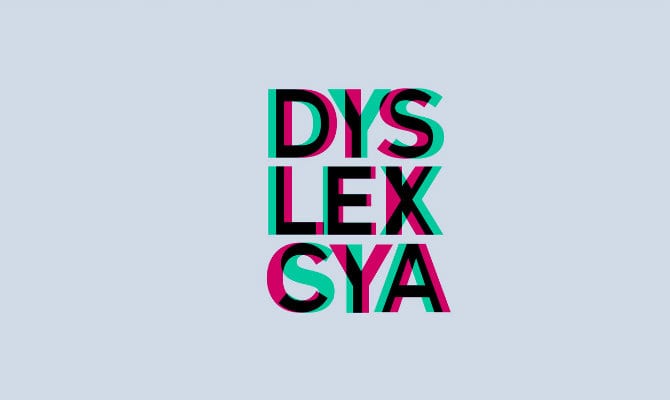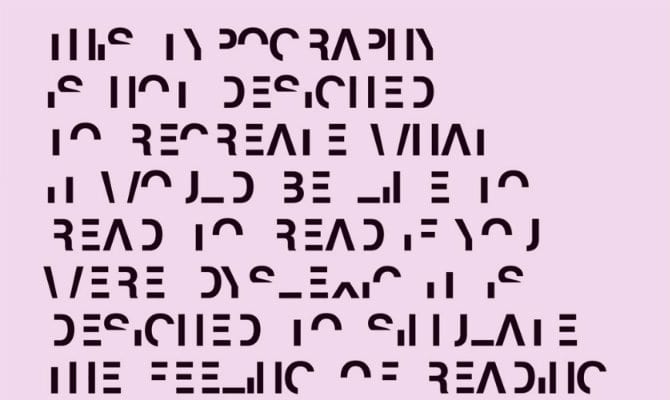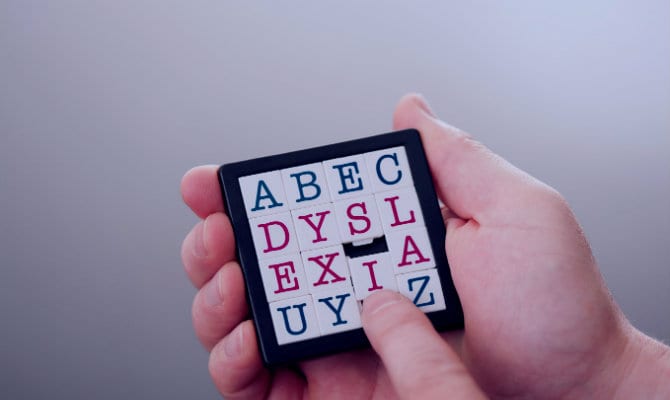Nowadays, the term of dyslexia, but few really know what it means. This is known as a reading dysfunction that manifests itself in children, adolescents and adults, and its incidence is much higher than might be thought. Precisely for this reason, we present the following article on this condition, in which points such as its definition, typology, symptoms, and treatments used to overcome it are developed.
Find out what dyslexia is and its meaning
Etymologically, the word dyslexia is made up of two words: dys, a word of Greek origin that is translated as difficulty; Y lexia, of Latin origin, which means to read. Therefore, a very literal translation of this term is difficulty reading.
It is defined as a difficulty in decoding and encoding the elements of language in regards to reading, writing, and even speech (specifically signs, letters); ucal occurs in individuals with completely normal cognitive abilities. This difficulty has its origin in brain dysfunctions, with those that are born or that are acquired as a result of an accident in the course of life.
Therefore, a person who cannot read or write at the age when it is considered normal for him to do so can be considered dyslexic; Without having any type of delay or intellectual disability, sensory disability (hearing problems, vision problems, for example) and with a correct pedagogical guide.

Some authors, like Harstein, Debray and Melékian, consider it as a learning disorder. Others see it as a specific and differentiated learning problem, such as Critchley, Nieto and Padget, due to confusion regarding symptoms. The truth is that today, most people are not clear about what dyslexia is. The term is colloquially used to refer generally to general reading and learning disorders, which is wrong.
Regarding its incidence, this difficulty affects between 5 and 10% of school-age children, of which about 80% belong to the male gender. In fact, out of every four people affected, three are men. This was attributed in ancient times to the greater importance given to their education. However, in our current society both boys and girls attend school without any impediment. Therefore, a specific cause that causes dyslexia in a greater proportion in one gender than in another is not yet known.
The way in which dyslexia disorder affects people's lives will depend mainly on the degree of difficulty (if it is at a level low, medium or serious). In this way, there are people with a slight degree that allows them, in turn, to stand out in the field of calculus and mathematics in general; or others with a more accentuated level but who can still function in professions such as electrical technicians, craftsmen, goldsmiths, designers and tailors. Finally, those cases of greater severity in which this condition represents a weight impediment, and that trains people only for very elementary tasks.
What are the types of dyslexia?
There are several learning difficulties, dyslexia is one of them and can be divided into different types, which will depend on the difficulty that the person who suffers from it has.
a) Acquired dyslexia:
It refers to dyslexia that originates in the individual who has already learned to read, after an accident that caused the brain dysfunction. In turn, these are subdivided into peripheral and central, whose identification will depend on whether the effect of the injury affects the perception of the information or its processing.
Peripheral dyslexia:
- Attention for: It was proposed by Patterson in 1981, and refers to those cases in which patients can identify words globally, as well as identify isolated letters. However, they are unable to identify each of the letters that make up a word.
- Visual: In this case, individuals mistake the words for others that are graphically similar. For example, they read mass instead of table; sun instead of salt, among others. However, they can identify the letters of words that they are unable to read. This type of dyslexia was described by Marshall in 1984, three years after the appearance of attention.
- Letter by letter: Of the types of dyslexia mentioned, this is influenced by the length of the words. The letter by letter type is one that manifests itself when the individual has the need to read aloud, or internally, each of the letters that make up a certain word.

Central dyslexia: The patient has difficulties to relate the graphic sign with the meaning of the word; This is due to dysfunctions in the routes that serve as a means of linking them. Depending on the route through which it is difficult to make this correlation, central dyslexia is classified into:
- Phonological: The patient presents impairment in the phonological pathway, since they are able to read known words through the visual pathway, but they are unable to read new, unknown or invented words. Someone with phonological dyslexia might read lopo instead of wolf, for example.
- Superficial: It manifests itself especially with the incorrect reading of irregular words, usually words borrowed from other languages, which have a very similar writing and pronunciation in the affected language; for example, "hall". It is related to the damage of three points in the visual path: the visual lexicon, the semantic system and the phonological lexicon.
- Semantics: The patient has the ability to read words through the visual lexicon and the phonological lexicon, however, he will not be able to find their meaning. In this type of dyslexia, there is a dysfunction in the connection between the visual lexicon and the semantic system, which prevents the extraction of the total message.
- Deep: This is one of the most serious types of dyslexia, as its name indicates, since the individual will have difficulties both in reading pseudowords or irregular words, and in finding their meaning. The patient with profound dyslexia will present both the symptoms of impairment in the visual path, as well as those of impairment in the phonological path. In this way, they will be able to read "table" where it says "chair".
b) Evolutionary dyslexia:
Also called developing dyslexia, it is that dysfunction that originates in the individual while learning to read, and continues even after this. The symptoms in this case are very similar to those of those suffering from the acquired type, but in this case, they will not be caused by brain lesions.
Symptom
Once the different types of dyslexia are exposed, one can get an idea of the signs related to this disorder. However, in this section we present a general breakdown of the most common dyslexia symptoms in individuals who present it, and which in turn are used for its diagnosis:
- present a slow reading, compared to children of the same level. This is a characteristic feature of dyslexic people and is very common as the child begins to read long sentences and texts.
- They regularly lose the order of the lines of a certain text, and in fact, to guide themselves, they use one of their fingers to point to the line they are on.
- They invert the letters that make up the words. In this way, they can confuse "b" with "p" or "q".
- While reading texts, they invent words with graphic signs similar to those of the original. They may or may not be consistent with the context of the reading.
- They can write in front of the mirror sporadically.
- They present difficulties to spell words, before which they present many doubts, and in general, they change the order of the letters.
- They read articles, prepositions and conjunctions (called function words) with great difficulty, since they do not have a meaning to which they can relate.
- They present notable difficulties in learning a new language.
- They have difficulty pronouncing polysyllabic words.
- It is difficult for them to learn the multiplication tables.

Causes of dyslexia
Despite being a disorder that has been studied since the mid-XNUMXth century, the causes of dyslexia remain unknown today. In general, we have described dyslexia according to its origin as evolutionary and acquired. The causes of the latter are clear. although there are factors related to the symptoms, covered in certain theories that try to explain rather the origin of the evolutionary nature. Some of the most accepted hypotheses are described below:
- Genetic causes: This is one of the most discussed causes. Some scientists have attributed the development of this dysfunction to chromosomes 15 and 6, related to the development of different forms of reading dysfunction. However, no strong evidence has been presented to support this claim.
- Neurological causes: Regarding this point, congenital anomalies of a neurological nature, congenital functional disorders have been mentioned, but the truth is that, as in the genetic theories of the causes of dyslexia, there is not enough evidence to ensure that it originates neurological.
- Hormonal causes: Some authors associate it with the presence of male hormones, which would explain the higher incidence of the disorder in men.
- Sensory causes: These were described in the types of acquired dyslexia. Sensory causes can be visual, auditory and phonological. The former are due to difficulties in visual processing. These can be due to perceptual distortion, abnormal eye movements, which could make it difficult to follow the order of the letters during reading. The auditory ones, in which the origin of the disorder is in the difficulty to hear. Finally, the phonological causes, to which difficulties are attributed to segment the phonemes that make up language.
- Psychological causes: The theory that attributes the causes of dyslexia to the psychological aspect is quite interesting. Some authors associate the disorder with a deficit in the relationship of sounds and language signs. Others relate it to affective problems or environmental factors that influence the child's motivation and ability to learn. Finally, some followers of behaviorism claim that it is an acquired bad habit, so their treatment seeks to end the behavior.
- Pedagogical causes: Related to wrong, cruel or misapplied pedagogical practices. However, this theory is also highly disputed since under these same techniques some children develop dyslexia, and others do not.

Effective treatment
The treatment of dyslexia must include the entire life cycle of the sufferer. Thus, in its detection at an early age, it will require techniques to solve reading difficulties. At this point mention is made of guided reading programs; of which one of the most famous is orton gillingham (OG), better known as Multisensory and Structured Language Teaching (MSLE). This is considered the most effective tool for teaching children with dyslexia.
- The MSLE program uses all the senses to teach children to read. For example, students can learn a certain letter by looking at it, pronouncing it, writing it with different materials in such a way that they can also feel or smell it.
- In addition, it is required to entrust the child to specialized professionals in the area; to help you recognize the sounds of words, separate the sounds from the same and mix them to form new ones, for example. This is known as creating phonological awareness. Thus, they will also learn to pronounce words they do not know (decoding).
- It is recommended, in the classroom, to teach children preferably in small groups. Similarly, carry out activities that allow one or two types of phonemes to be manipulated, instead of several at the same time, as is customary.
- Some, depending on the origin of dyslexia, propose eye exercises that stimulate and improve the individual's visual perception, although this method is currently highly questioned.
In the case of university students, the treatment of dyslexia is guided to help, since at this point it is more complex to attack this problem. University students must apply in the same way reading exercises, that will help them capture the information. However, this is a chronic disorder, so in the same way they will require much more time to study and to carry out their tasks.
At present, technological advances can significantly facilitate the lives of dyslexics, especially in the student stage. There have been recorders for several years that they can use in class, to replace reading from time to time; laptops with spell checkers, voice-recorded books, tutorials and special services offered by educational institutions for these particular cases.
To conclude, once all about this common problem is known, we invite you to leave your opinion or experience about the subject in the comment box. You can also share the article on your social networks to publicize this problem that affects so many children and ordinary people today.
The article is very good and interesting, it has been very useful to me. Thanks.
excellent information, it has been very useful to me. Thanks
Excellent contribution!
I would like to know the name of the author
regards
Good article, it helped me a lot… Thank you
Regards!!